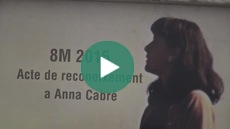Do you know Observatory for Equality at UAB?
Video explains the tasks and objectives of Observatory which highlights the main activities and actions too

What do we do?
The Observatory for Equality is mainly engaged in the analysis of inequalities in higher education, and more specifically in the study and diagnosis of sexism and inequalities by disability, from an intersectional perspective.
It operates within the UAB with the aim to provide information to the community about the situation of inequalities in the campus, in comparison with the international context. Among its goals we endeavour to raise awareness of the different forms of inequality and discrimination, and to disseminate methods and resources designed to correct them. We target all members of the university community: teaching and researching staff, administration and services staff, and students.
In order to design and implement equality policies, we elaborate, monitor, and evaluate action proposals focused on correcting inequalities. Advising, training, prevention and participation in equality are then the key strategies to transform power relationships in the University from a gender perspective.
History
In accordance with the Twelfth Additional Provision of the Organic Law of Universities 4/2007, universities shall have equality units among their organizational structures to develop functions related to the equality principle between women and men.
This unit at Universitat Autònoma de Barcelona is called Observatory for Equality and started its activities in 2005, focusing its efforts on inequalities between women and men. The Observatory enhanced its scope in 2008 to those groups that might endure adverse conditions because of discrimination or economic and social situations (immigration, age and sexual orientation).
The Observatory for Equality is a university entity created by the Governing Council of Universitat Autònoma de Barcelona to serve as technical support in designing and evaluating equality policies.
In recent years, the Observatory for Equality has included the gender intersecting perspective in the analysis of inequalities in higher education and has expanded its lines of action: education, equality and participation, and gender-based violence. It should also be noted the implementation of awareness-raising campaigns in a last period.
Video explains the tasks and objectives of Observatory which highlights the main activities and actions too

15th Institutional Event to commemorate International Women's Day

14th Institutional Event to commemorate International Women's Day.

XIII Institutional Conference in commemoration of the International Women's Day.

The UAB hosted on 18-20 January 2016 the research and discussion sessions of the EGERA project.

Campaign #Communicaction and invites everyone to report and respond to situations of discrimination at UAB

Action conducted by the Observatory for Equality within the campaign “Sense set de sexisme” on the occasion of the UAB’s Festival in 2014.

By the Observatory for Equality on the occasion of the UAB’s Festival in 2014.

Video in recognition of the honouree’s professional career, Fátima Bosch PhD


Dissemination video for the minute of silence and the manifesto’s lecture to commemorate the victims of gender-based violence

III International Congress of Miseal: “New challenges in Social Inclusion and Equality in Higher Education”

III International Congress of Miseal: “New challenges in Social Inclusion and Equality in Higher Education”

III International Congress of Miseal: “New challenges in Social Inclusion and Equality in Higher Education”

III International Congress of Miseal: “New challenges in Social Inclusion and Equality in Higher Education”

Campaign #Communicaction and invites everyone to report and respond to situations of discrimination at UAB

Campaign #Communicaction and invites everyone to report and respond to situations of discrimination at UAB

Dissemination video where UAB students answer the question: ‘Is there sexism at UAB?’

Dissemination video to raise awareness on the jobs by women in all fields of work.